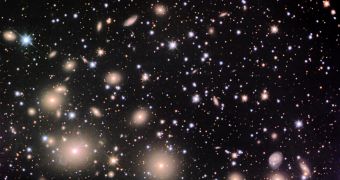While quite controversial initially, most astrophysicists would agree today that the Universe is expanding. No one can explain why it's expanding, this is why the theoretical dark energy was introduced, but there's little doubt that galaxies are pulling farther and farther apart.
But that's not to say that everyone agrees. An interesting new paper by Cosmologist Christof Wetterich of the University of Heidelberg proposes a model in which the universe isn't in fact expanding, but rather gaining mass.
The way astronomers know the universe is expanding is because of the redshift effect, i.e. light from distant sources is stretched by the time it arrives here, causing its wavelength to increase and its frequency to decrease. For visible light, the effect is that it becomes redder, hence the name.
But the new paper has a different explanation for the color discrepancy. Light emitted by atoms is linked to their mass, i.e. heavier electrons are more energetic and emit more energetic light.
If the total mass of the universe was smaller in the past, light emitted by atoms then would be redder than the light emitted by the same atoms now.
Of course, all of this depends on the entire universe, every particle gaining mass over time. Because the gain in mass of each particle would be proportional, it would be impossible to detect this gain, since all mass measurements are relative to each other.
The theory hasn't been peer reviewed yet, it's only been added to arXiv. Radical ideas like this are usually proved wrong fairly quick, but sometimes they completely change our understanding of the universe.
If the theory were correct, it would have very big and interesting repercussions. For example, there would be no singularity requirement in the Big Bang, which in turn would mean that our universe existed before the Big Bang and that we can know how that old universe was.

 14 DAY TRIAL //
14 DAY TRIAL //